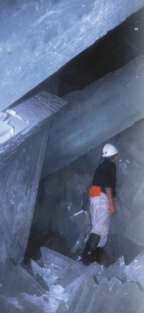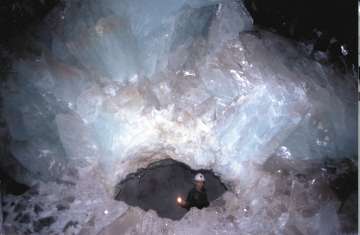







 |
 |
 |
 |
|||||
 |
 |
 |
||||||
 |
||||||||
 Translucent
gold and white selenite crystals growing up to 50 feet high and four feet
in diameter crowd the space inside a cave in southern Chihuahua, Mexico.
Dubbed Las cuevas de los cristales, the cave of the crystals is an extension
of the Naica Mine, and was found after a blasting 300-meters deep that
revealed an open fissure in April 2000. The mine harbors a variety of minerals
in its limestone bedrock, including: gypsum, zinc, calcite, galena, pyrite,
anhydreite, fluorite,
Translucent
gold and white selenite crystals growing up to 50 feet high and four feet
in diameter crowd the space inside a cave in southern Chihuahua, Mexico.
Dubbed Las cuevas de los cristales, the cave of the crystals is an extension
of the Naica Mine, and was found after a blasting 300-meters deep that
revealed an open fissure in April 2000. The mine harbors a variety of minerals
in its limestone bedrock, including: gypsum, zinc, calcite, galena, pyrite,
anhydreite, fluorite,  silver,
copper and chalcopyrite. The mine was first made famous for large selenite
crystals in 1910 when a similar cave known as las cuevas de las espadas
was found at a depth of 120 meters. But the cave of swords is no match
for the crystals in the newly exposed cavern. Temperatures of 60 degrees
Celsius (140 degrees Fahrenheit) and 100 percent humidity have stymied
physical exposure of the cave to scientists and pictorial exposure to the
public. Richard Fisher director of Wilderness Research Expeditions, a non-profit
organization in Tucson, Ariz., captured these recent shots of the cave.
Rock and Gem magazine published some of Fisher’s pictures in its
February issue.
silver,
copper and chalcopyrite. The mine was first made famous for large selenite
crystals in 1910 when a similar cave known as las cuevas de las espadas
was found at a depth of 120 meters. But the cave of swords is no match
for the crystals in the newly exposed cavern. Temperatures of 60 degrees
Celsius (140 degrees Fahrenheit) and 100 percent humidity have stymied
physical exposure of the cave to scientists and pictorial exposure to the
public. Richard Fisher director of Wilderness Research Expeditions, a non-profit
organization in Tucson, Ariz., captured these recent shots of the cave.
Rock and Gem magazine published some of Fisher’s pictures in its
February issue.
CR
For more information on the cave, read
Mexico's Copper Canyon (www.coppercanyon.org)
or write to Wilderness Expeditions, P.O. Box 40092, Tucson, AZ 85717
 |
Geotimes Home | AGI Home | Information Services | Geoscience Education | Public Policy | Programs | Publications | Careers |